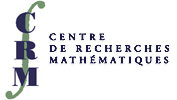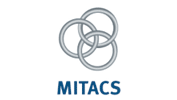 |
|
||||
Org: Jose Luis Cisneros-Molina (UNAM), Ian Hambleton (McMaster) and Miguel Xicotencatl (CINVESTAV)
[PDF]
- ALEJANDRO ADEM, University of British Columbia
Commuting Elements and Simplicial Spaces of Homomorphisms [PDF] -
Using spaces of homomorphisms and the descending central series of the free groups, simplicial spaces are constructed for each integer q > 1 and every topological group G, with realizations B(q,G) that filter the classifying space BG. In particular for q=2 this yields a single space B(2,G) assembled from all the n-tuples of commuting elements in G. Related stable splittings for spaces of commuting elements in a compact Lie group will also be discussed.
- JIM BRYAN, Department of Math, UBC
The Donaldson-Thomas and Gromov-Witten theory of orbifolds and their resolutions [PDF] -
There are two primary theories of "curve counting" on a Calabi-Yau threefold, Donaldson-Thomas theory and Gromov-Witten theory. Both theories extend to Calabi-Yau orbifolds. A three dimensional Calabi-Yau orbifold X has a canonical Calabi-Yau resolution Y. The four curve counting theories DT(X), DT(Y), GW(X), and GW(Y) are expected to be equivalent. We give an overview of these theories and conjectural equivalences.
- RYAN BUDNEY, Mathematics and Statistics, University of Victoria, PO Box 3045, STN CSC, Victoria, BC, V8W 3P4
Smooth embeddings of 3-manifolds in the 4-sphere [PDF] -
An old theorem of C. T. C. Wall's states that every 3-manifold admits a smooth embedding in the 5-sphere. So if M is a closed 3-manifold different from the 3-sphere, the lowest-dimensional sphere that it embeds in is either 4 or 5. This talk will explore what is known about which closed 3-manifolds admit smooth embeddings into the 4-sphere.
- OLIVIER COLLIN, Université du Québec à Montréal
Applications of instanton Floer homology to knots [PDF] -
In the last decade, 3-manifold topology has seen the first major applications of the ideas developed 20 years ago by the late Andreas Floer, most notably through the use of the Heegaard-Floer homology defined by Ozsváth and Szabó. Through recent work of Kronheimer and Mrowka, many of these advances can be recovered through a version of instanton Floer homology. In this talk we aim to look at some consequences for SU(2)-representation varieties of knots in S3. In particular we shall explain how SU(2)-representation varieties of 2-fold branched covers detect the unknot and give a simple proof of a classical result of Scharlemann which asserts that unknotting number 1 knots are prime.
- MARIO EUDAVE, Instituto de Matematicas, UNAM, Circuito Exterior, Ciudad Universitaria, 04510 Mexico DF, MEXICO
The Hexatangle II [PDF] -
A tangle is a pair (B,A), where B is the 3-sphere with the interiors of a finite number of 3-balls removed, and A is a disjoint union of properly embedded arcs in B such that A meets each component of ¶B in four points. The Hexatangle is a certain tangle having six boundary components and a projection into the plane with no crossings. By filling the boundary components of a tangle with rational tangles we get knots and links in the 3-sphere. In a previous work we determined all the integral fillings on the hexatangle that produce the trivial knot. Now we consider arbitrary rational fillings of the hexatangle, and have a conjecture which says exactly when we can get the trivial knot. We show some partial results about this conjecture. The double branched cover of the hexatangle is a certain hyperbolic link L of six components in S3. Our problem is equivalent to determining all Dehn surgeries on L that produce the 3-sphere. This link is interesting, for infinitely many hyperbolic knots which have exceptional surgeries are obtained by performing surgery on 5 components of L, and then a solution of the conjecture will lead to a listing of all such knots that are obtained from L.
This is joint work with Lorena Armas-Sanabria.
- SAM GITLER, Cinvestav, Mexico
Moment angle complexes [PDF] -
I will speak on new developments in moment angle complexes and toric topology.
- JESUS GONZALEZ, CINVESTAV
Symmetric topological complexity of projective spaces [PDF] -
Topological complexity was introduced by M. Farber as a way to measure intrinsic hardness in motion planning algorithms. It has been shown that this invariant captures the immersion dimension of projective spaces. I will describe the corresponding relationship between symmetric topological complexity and embedding dimension.
This is joint work with Peter Landweber.
- FRANCISCO J. GONZALEZ-ACUÑA, Universidad Nacional Autónoma de México, Instituto de Matemáticas, Circuito Exterior, Ciudad Universitaria, 04510 México D.F.
Higher dimensional manifolds with S1-category two [PDF] -
A subset U of a closed topological n-manifold M is S1-contractible (in M) if there exist maps f : U ® S1, a: S1 ® M such that the inclusion of U into M is homotopic to af.
M has S1-category £ k if it can be covered by k open subsets which are S1-contractible.
Previously we have determined, for n £ 3, the n-manifolds with S1-category 2.
Theorem 1 If n > 3 and Mn has S1-category 2 then Mn is an n-sphere or an Sn-1-bundle over S1.
With J. C. Gómez-Larrañaga and W. Heil. - RICK JARDINE, University of Western Ontario, Dept. of Mathematics, London, ON, N6A 5B7
Pointed torsors and Galois groups [PDF] -
Suppose that H is an algebraic group which is defined over a field k, and let L be the algebraic closure of k. The canonical stalk for the etale topology on k induces a simplicial set map from the classifying space B(H-tors) of the groupoid of H-torsors (a.k.a. principal H-bundles) to the space BH(L). The homotopy fibres of this map are groupoids of pointed torsors, suitably defined. These fibres can be analyzed with cocycle techniques: their path components are representations of the absolute Galois groupoid in H, and each path component is contractible. The arguments for these results are simple, and applications will be displayed.
- ERNESTO LUPERCIO, Cinvestav
Non-compact Frobenius Algebras [PDF] -
In this talk I will report on my joint work with Ana Gonzalez and Carlos Segovia on the study of a generalization of Frobenius Algebras motivated by String Topology.
I will explain of the relation of such algebras with topological field theories, and to orbifolds.
- LIVIU MARE, University of Regina, Regina, SK, S4S 0A2, Canada
Equivariant cohomology of flag manifolds [PDF] -
The complex flag manifold Fln (C) is the space of all nested sequences
where each Vk is a vector subspace of Cn, dimVk = k. The group T of all diagonal unitary n×n matrices acts canonically on this space. The corresponding equivariant cohomology ring H*T ( Fln (C) ) admits two presentations: of Borel type (in terms of generators and relations) and of Goresky-Kottwitz-MacPherson type (in terms of restrictions to the fixed points of the action). In this talk I will present similar descriptions of the equivariant cohomology rings of the quaternionic and the octonionic flag manifolds relative to some appropriate group actions. The equivariant (topological, complex) K-theory of these spaces will also be discussed briefly.V1 Ì ¼ Ì Vn, - EDUARDO MARTINEZ-PEDROZA, McMaster University
Immersion of Surfaces in 2-Dimensional Complexes [PDF] -
An outstanding conjecture by M. Gromov asserts that a one-ended hyperbolic group contains a subgroup isomorphic to the fundamental group of a closed surface. Motivated by this conjecture, we study the existence of immersions of closed surfaces in 2-dimensional CW-complex. Our results provide sufficient conditions for the existence of such immersions and imply the existence of surface subgroups in a particular class of hyperbolic groups.
Joint work with M. Forester and N. Brady.
- ANDY NICAS, McMaster University
The horofunction boundary of the Heisenberg group [PDF] -
We find the horofunction boundary of the (2n+1)-dimensional Heisenberg group with the Koranyi metric and show that it is homeomorphic to a 2n-dimensional disk. We also show that the Busemann points correspond to the (2n-1)-sphere boundary of this disk and that the compactified Heisenberg group is homeomorphic to a (2n+1)-dimensional sphere. As an application, we find all isometries of the Koranyi metric.
This is joint work with Tom Klein.
- DANIEL JUAN PINEDA, UNAM-Morelia
Algebraic K-theory of virtually free groups [PDF] -
We will indicate how to compute the algebraic K-theory groups of virtually free groups using the following facts:
(1) these are hyperbolic groups;
(2) they satisfy the Farrell-Jones Conjecture for K-theory. - DALE ROLFSEN, University of British Columbia, Vancouver
the space of orderings of a group [PDF] -
A group is left-orderable if there is a strict total ordering < of its elements so that y < z implies xy < xz. If a group G is left-orderable, the set LO(G) of all left orderings has a natural topology, introduced by Sikora. I will outline the current state-of-the-art in understanding the space of orderings, and some of the applications of this theory.
- DONALD STANLEY, University of Regina, Regina, Saskatchewan, Canada
A simply connected counter-example to Ganea's Conjecture of Smallest Dimension [PDF] -
For a topological space X, cat(X) is one less than the least number of open sets in X that it takes to cover X. Ganea conjectured that for any X, cat(X ×Sn) = cat(X)+1. In 1997 Iwase constructed a series of counterexamples using the instability of certain Hopf invariants. The least dimension of the counterexamples was ten. On the other hand results of Vandembrouq imply that no simply connected counterexamples exist with dimension less that or equal to five. We construct a counter-example of dimension seven. Instead of unstable Hopf invariants, the example comes from a Hopf invariant stably factoring through another map. We will also discuss the remaining question of counterexamples of dimension six.
This is joint work with Hugo Rodriguez.
- PETER ZVENGROWSKI, Department of Mathematics and Statistics, University of Calgary, Calgary, AB, T2N 1N4
Span de Variedades de Stiefel Proyectivas / Span of Projective Stiefel Manifolds [PDF] -
En esta conferencia se hace un extracto de algunos de los resultados conocidos del span de las variedades de Stiefel proyectivas reales Xn,r; también se presentan algunos avances recientes obtenidos por P. Sankaran, J. Korbas y el autor.
En el estudio de éste, se han aplicado numerosas técnicas, entre otras, fibrados vectoriales, clases características, operaciones cohomológicas primarias y secundarias, K/-teoría, álgebras de Cayley-Dickson, bordismo normal, etc., conduciendo a resultados fuertes e incluso, en muchos casos, a resulados exactos. El caso Xn,2, con n impar, parece ser el más difícil y a éste se le prestará especial atención en esta charla.
In this talk some of the known results on the span of the real projective Stiefel manifolds Xn,r will be summarized, and some recent improvements due to work of P. Sankaran, J. Korbas, and the author will be presented. A wide variety of techniques have been applied to this problem, including vector bundles, characteristic classes, primary and secondary cohomology operations, K-theory, Cayley-Dickson algebras, normal bordism, etc, leading to sharp and even exact results in many cases. The case Xn,2 with n odd seems to be the most difficult, and will receive special attention in the talk.






